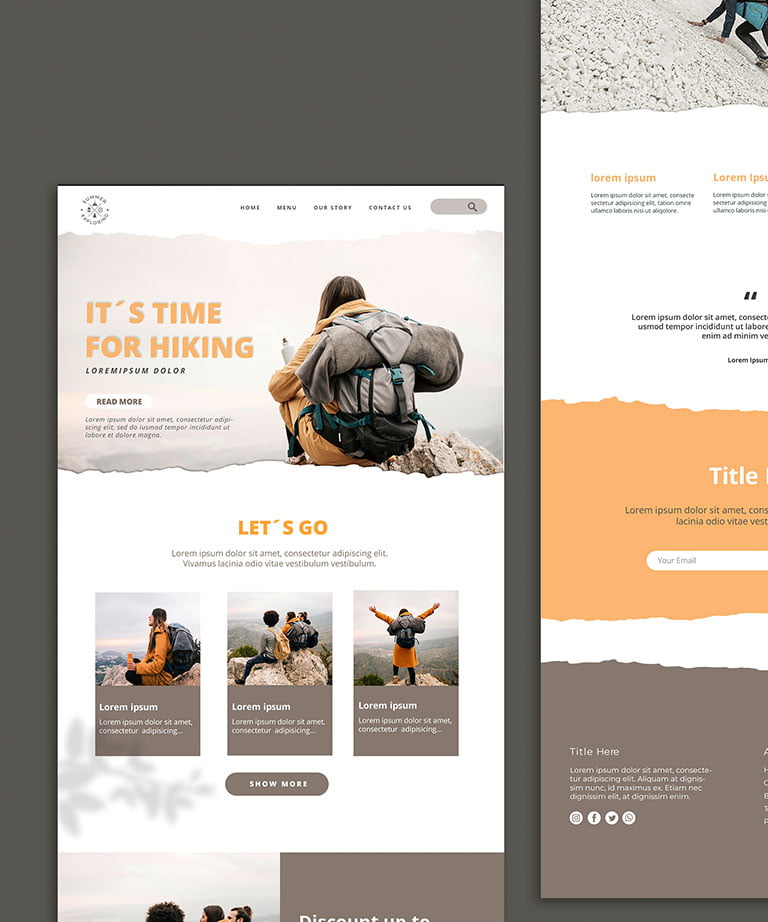Ecommerce Website Design
- Topics: Business Website, Ecommerce
- Resources: Digital Marketing Resources, Web Design Resources
The world of commerce has evolved dramatically over the past few decades, and the internet has played a pivotal role in this transformation. Ecommerce, short for electronic commerce, has become a fundamental part of the modern business landscape. As more consumers turn to online shopping, the importance of effective ecommerce website design cannot be overstated. In this article, we will delve into the intricacies of ecommerce website design, exploring the key principles, strategies, and best practices that can help businesses create compelling online shopping experiences for their customers.
The Importance of Ecommerce Website Design
Ecommerce website design is pivotal in the digital age, shaping user impressions and influencing behavior as online shopping continues to surge. A well-crafted design enhances trust and drives conversions, making it a critical factor for online business success.
- The Growth of Ecommerce
Ecommerce has experienced explosive growth in recent years, with no signs of slowing down. According to Statista, global ecommerce sales reached $4.9 trillion in 2021, and this figure is projected to surpass $6 trillion by 2023. The convenience of shopping online, coupled with the ongoing COVID-19 pandemic, has fueled this surge in ecommerce activity. As more businesses venture into the digital realm, the competition for customers’ attention intensifies. In this context, an exceptional ecommerce website design is a crucial differentiator.
- The Role of Design in Ecommerce
Ecommerce website design is not merely about aesthetics; it encompasses the entire user experience. Design influences how users navigate a website, find products, make purchasing decisions, and ultimately complete transactions. An effective design can boost user engagement, increase conversion rates, and foster trust between the brand and the consumer. Conversely, a poorly designed website can frustrate users, drive them away, and harm a company’s reputation.
Principles of Ecommerce Website Design
In the world of ecommerce, the principle of user-centered design is akin to the North Star guiding the creation of every element on a website. By placing the needs and preferences of your target audience at the forefront of your design process, you ensure that every aspect of your website—from product listings to checkout—speaks directly to your users, creating an experience that resonates and facilitates conversions.
- User-Centered Design
At the heart of successful ecommerce website design lies the principle of user-centered design. Every element of the website, from the layout to the navigation, should prioritize the needs and preferences of the target audience. Understanding your users’ behavior, preferences, and pain points is essential to creating a website that resonates with them.
- Responsive Design
In an era where consumers access websites from a myriad of devices, responsive design is non-negotiable. Your ecommerce website should adapt seamlessly to various screen sizes, ensuring a consistent and user-friendly experience on desktops, tablets, and smartphones. Google’s mobile-first indexing also highlights the significance of mobile-friendly design for search engine optimization (SEO).
- Simplicity and Clarity
Simplicity is a hallmark of effective ecommerce website design. Cluttered layouts and excessive information can overwhelm visitors, leading to high bounce rates. Prioritize clear and concise product descriptions, intuitive navigation menus, and a straightforward checkout process. Ensure that users can easily find what they are looking for without unnecessary distractions.
- Visual Hierarchy
Visual hierarchy guides users’ attention to the most important elements on a webpage. Utilize visual cues like color, typography, and size to highlight key elements such as product listings, call-to-action buttons, and pricing information. A well-structured hierarchy can improve user engagement and conversion rates.
Key Elements of Ecommerce Website Design
Key elements of ecommerce website design include product listings and categories that are organized logically, a user-friendly search functionality to help users find products easily, engaging and informative product pages with high-quality imagery and persuasive descriptions, and a streamlined shopping cart and checkout process that minimizes friction. These elements collectively contribute to a seamless and enjoyable shopping experience for customers, increasing the likelihood of successful conversions and fostering customer loyalty.
- Product Listings and Categories
The way you present your products and categorize them has a significant impact on user experience. Organize products into logical categories and use high-quality images along with concise and compelling product descriptions. Implement filtering and sorting options to help users narrow down their choices quickly.
- Search Functionality
An effective search bar is a valuable tool for ecommerce websites. Implement features like auto-suggestions, spell-check, and filters to enhance the search experience. Additionally, ensure that the search results page provides relevant product listings, helping users find what they want with ease.
- Product Pages
Product pages are the digital storefronts of your ecommerce business. These pages should be informative, engaging, and persuasive. Include high-resolution images, detailed product descriptions, customer reviews, and pricing information. Highlight product features and benefits to help users make informed decisions.
- Shopping Cart and Checkout
The shopping cart and checkout process must be streamlined and user-friendly. A cluttered or confusing shopping cart can lead to cart abandonment. Offer a clear view of the cart’s contents, provide multiple payment options, and minimize the number of steps required to complete a purchase. Trust signals, such as security icons and guarantees, can instill confidence in shoppers.
Visual Design and Branding
Visual design and branding are the cornerstones of creating a distinct and memorable identity for any business. Visual design encompasses the use of colors, typography, imagery, and layout to convey a brand’s personality, values, and messaging. It is the artistic and creative aspect of branding that captures the essence of a company and communicates it visually to the audience. Consistency in visual design across various touchpoints, such as websites, logos, marketing materials, and products, reinforces brand recognition and trust. Effective visual design and branding evoke emotions, build connections with customers, and ultimately leave a lasting impression that sets a business apart in a crowded marketplace.
- Brand Consistency
Ecommerce website design should align seamlessly with your brand identity. Consistency in colors, typography, logos, and imagery reinforces brand recognition and trust. The website should reflect your brand’s personality, values, and messaging.
- Imagery and Photography
High-quality imagery is pivotal in ecommerce design. Invest in professional product photography that showcases products from various angles and in different contexts. Use visuals to tell a story and create an emotional connection with customers.
- Color and Typography
Color choices and typography play a crucial role in setting the tone of your website. Different colors evoke different emotions and associations, so select a color palette that aligns with your brand and resonates with your target audience. Typography should be legible and consistent across the website.
User Experience Optimization
User Experience Optimization, often abbreviated as UXO, is a crucial aspect of web and product design that focuses on enhancing the overall experience of users as they interact with a website, application, or digital product. It involves refining elements such as usability, accessibility, speed, and design to ensure that users find the product intuitive, enjoyable, and efficient to use. UXO aims to reduce friction in the user journey, improve satisfaction, and ultimately drive user engagement and conversions. Through continuous testing, research, and iterative design improvements, UXO plays a pivotal role in creating digital experiences that keep users coming back for more.
- Page Speed
Page speed is a critical factor in user experience. Slow-loading pages can deter users and harm your search engine rankings. Optimize images, use content delivery networks (CDNs), and leverage browser caching to improve loading times.
- Navigation
Intuitive navigation is key to helping users explore your website seamlessly. Implement a clear menu structure with logical categories and subcategories. Use breadcrumbs and site maps to assist users in finding their way around.
- Mobile Optimization
Given the increasing use of mobile devices for online shopping, mobile optimization is paramount. Test your website thoroughly on various mobile devices and ensure that all features work smoothly. Consider mobile-specific design elements, such as touch-friendly buttons and simplified menus.
- A/B Testing and Iteration
Continuous improvement is essential in ecommerce website design. Conduct A/B tests to assess the effectiveness of different design elements, such as button placement, color schemes, and call-to-action text. Use data-driven insights to refine your design and enhance user experience.
Trust and Security
Trust and security are foundational pillars of any successful online business. Trust is earned through transparency, reliability, and consistent delivery of promises, while security ensures the protection of sensitive customer information. In the digital age, customers must feel confident that their personal and financial data is safe when interacting with a website. Implementing robust security measures, such as SSL certificates, adherence to industry standards, and prominently displaying trust badges, helps instill confidence in users. Trust and security are not only essential for customer satisfaction but also for building a reputable and long-lasting online presence.
- Security Measures
Security is a top concern for online shoppers. Implement SSL certificates to secure data transmission, use trusted payment gateways, and adhere to industry-standard security protocols. Display trust badges prominently to reassure customers about the safety of their personal and financial information.
- Customer Reviews and Testimonials
Authentic customer reviews and testimonials can build trust and credibility. Feature these prominently on product pages to provide social proof of your product’s quality and customer satisfaction.
SEO and Ecommerce Website Design
SEO, or Search Engine Optimization, is a critical aspect of ecommerce website design. In the fiercely competitive online marketplace, a well-designed ecommerce website is only effective if it’s easily discoverable by potential customers. SEO techniques and strategies are integrated into the design process to ensure that the website ranks well in search engine results. This involves optimizing product descriptions, metadata, and content, as well as improving site speed and mobile-friendliness. Effective SEO not only enhances the website’s visibility but also drives organic traffic and ultimately contributes to higher conversion rates, making it an indispensable component of successful ecommerce website design.
- SEO-Friendly URLs
Optimize your website’s URLs for search engines by using descriptive keywords and avoiding unnecessary parameters. Clean, concise URLs are more user-friendly and contribute to better SEO rankings.
- Schema Markup
Implement schema markup to provide search engines with structured data about your products. This can result in rich snippets in search results, enhancing visibility and click-through rates.
- Content Strategy
A well-defined content strategy can boost your website’s SEO. Create informative blog posts, buying guides, and product descriptions that incorporate relevant keywords. High-quality content can also attract backlinks, further improving your search rankings.
Conclusion
A well-defined content strategy can boost your website’s SEO. Create informative blog posts, buying guides, and product descriptions that incorporate relevant keywords. High-quality content can also attract backlinks, further improving your search rankings.




